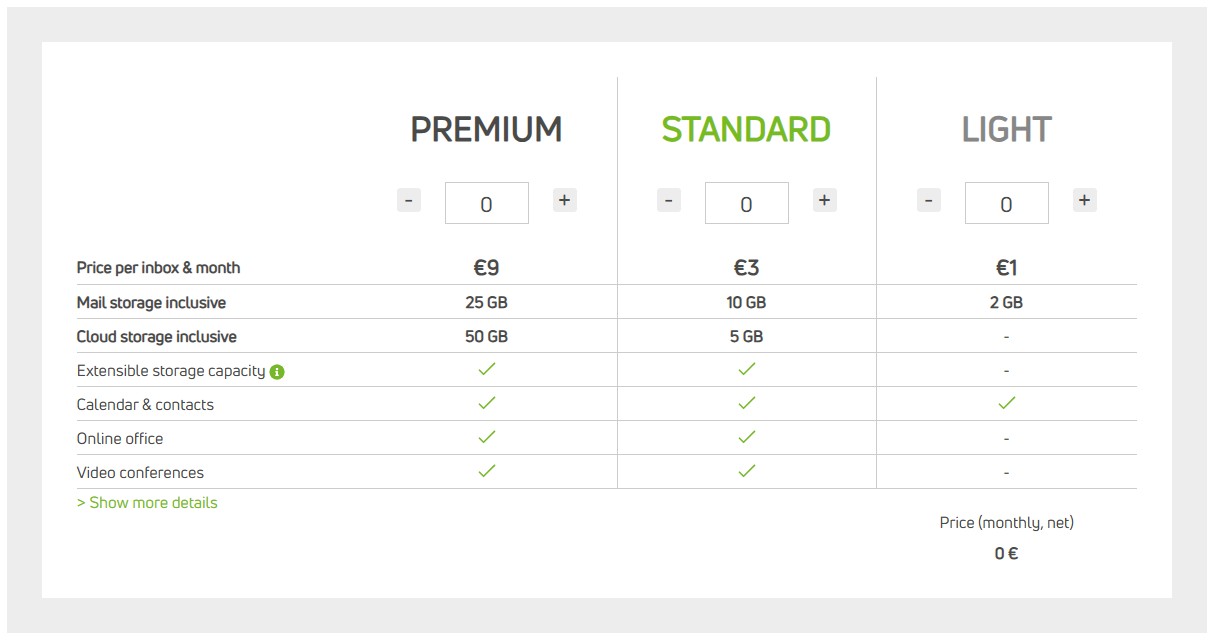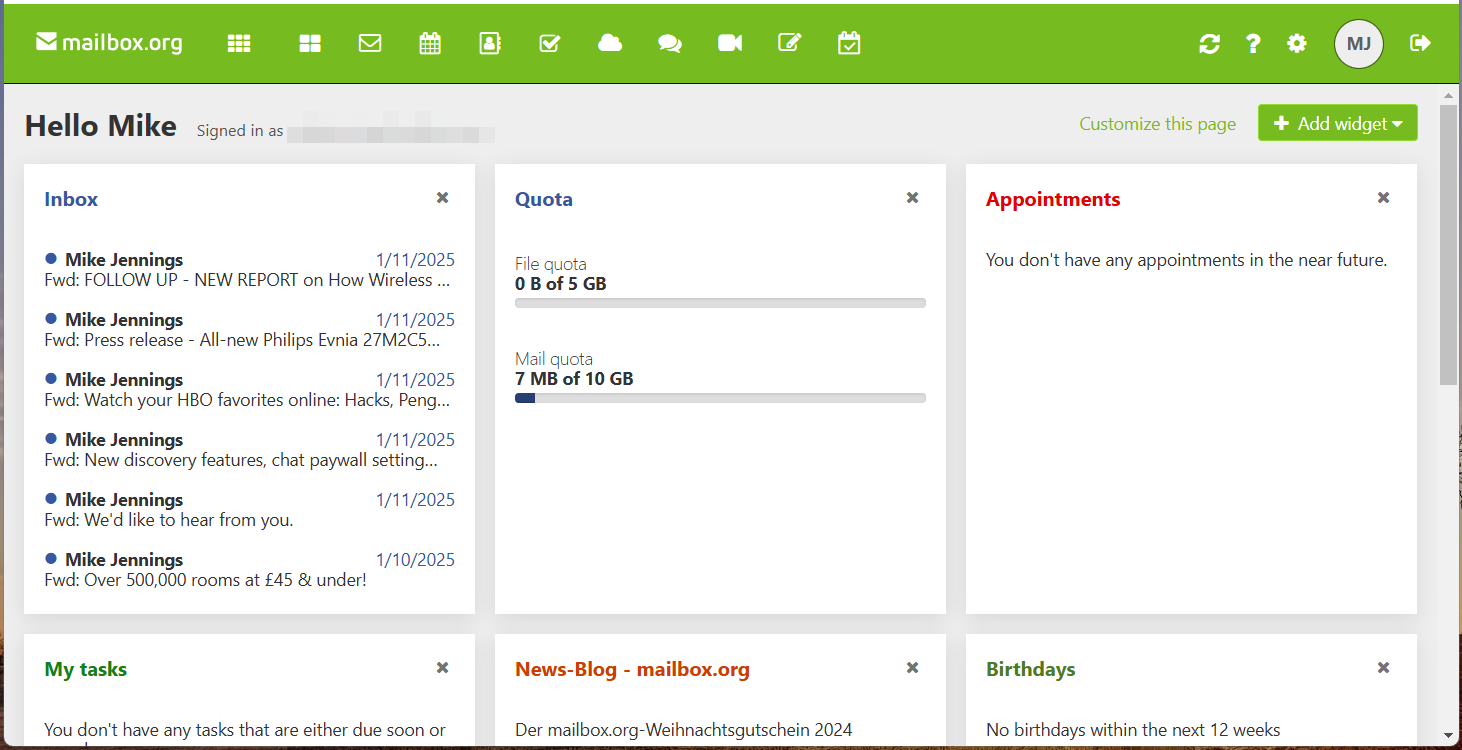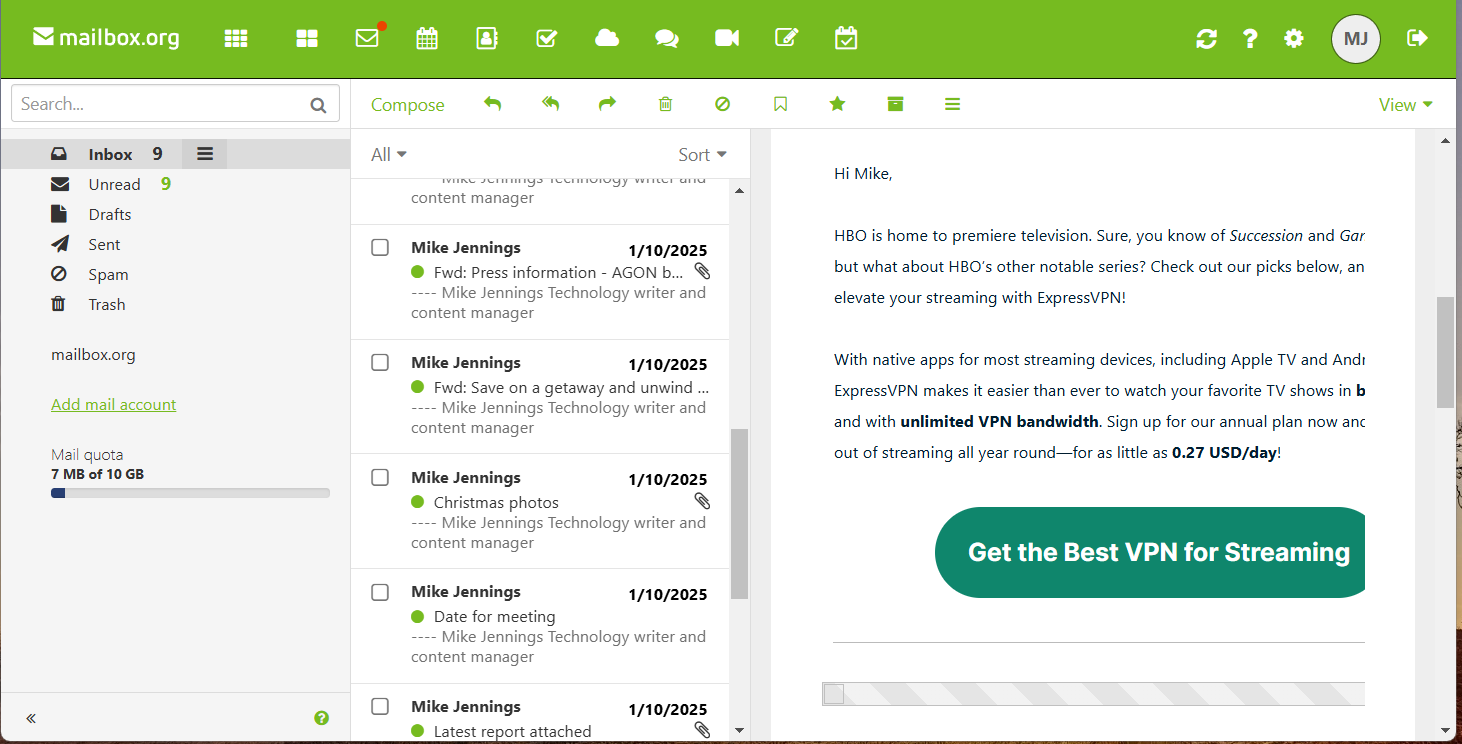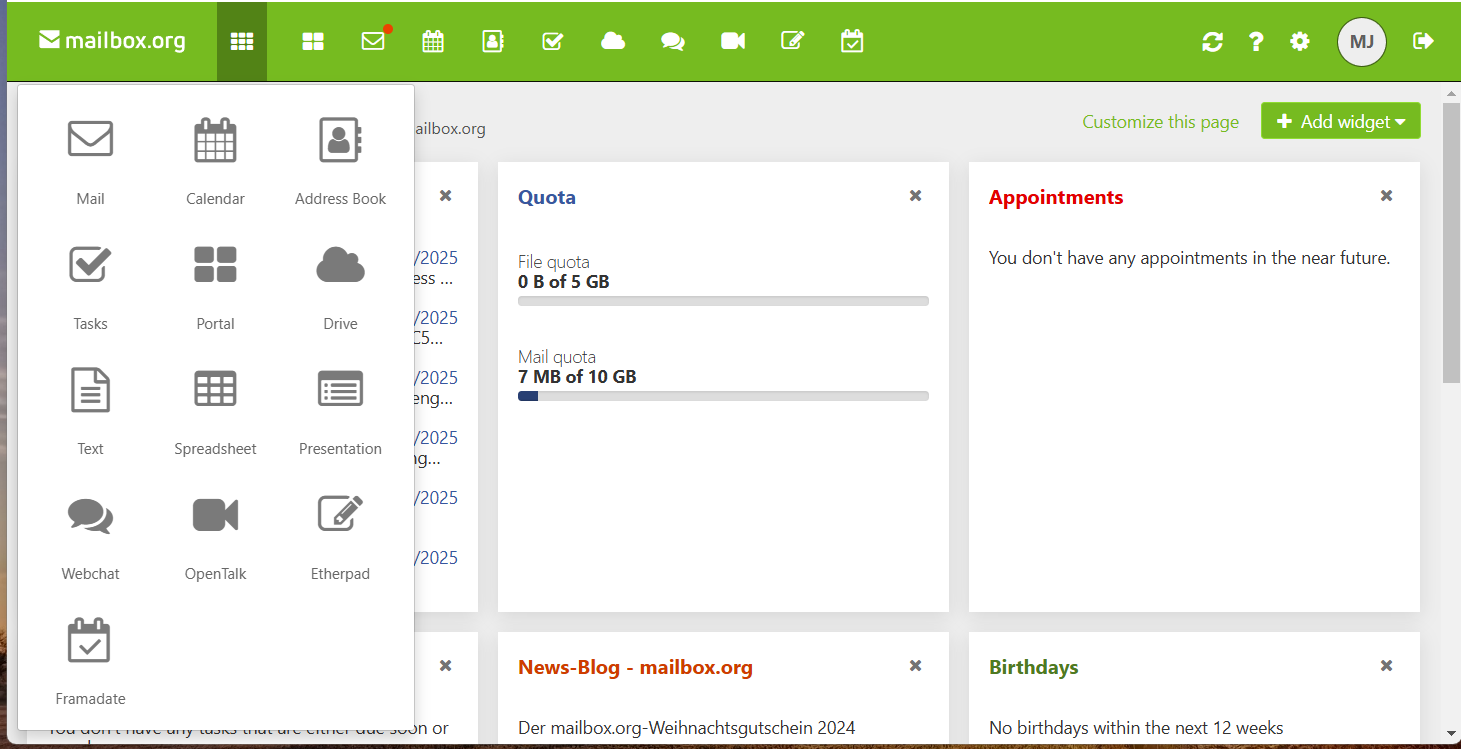Why you can trust TechRadar
We spend hours testing every product or service we review, so you can be sure you’re buying the best. Find out more about how we test.
Mailbox.org is rated as one of the best secure email providers in the world and is certainly one of the most well-known.
It was launched in 2014, following the global surveillance revelations spearheaded by whistleblower Edward Snowden. It is a rework of JPBerlin, a German email hosting service.
So, while Mailbox.org has been around for just over a decade, JPBerlin started two decades before that – suffice to say there’s plenty of experience behind Mailbox.org’s tech. Happily, Mailbox.org uses 100% green energy, and the organization is privately funded with no debt – so there’s less chance of outside interference from investors.
The focus here is on security and privacy, and these days thousands of individuals and businesses rely on Mailbox.org for their emails. And while you do have to pay for this service – and most other secure email providers – it’s worth investing if you don’t want to use a free email service where your data becomes the product.
Mailbox.org: Plans and pricing

No free options are available with Mailbox.org, but you can test the product with a free thirty-day trial. That’s a better deal than many competitors, who offer fourteen-day trials.
It’s not expensive to get started, either: Mailbox’s Light plan costs just €1/$1/£1 per month. This Light plan gives you access to 2 GB of email storage and three alias addresses. The Light plan benefits from the same secure email as pricier tiers, with servers based in Germany and ad- and tracking-free services. You also get a calendar and contact book.
The Light plan has restrictions – no cloud storage or online office app features, custom domain names only available in team accounts, and no video conferencing.
You get limited support, no phone support, no compliance with German BRAO legislation and no GDPR-compliant CDP agreement.
The Standard plan costs €3/$3/£3 and beefs up the offering: you get 10GB of email storage, 5GB of cloud storage, and the ability to edit documents, use video conferencing, and use custom domain names. You can also deploy 25 aliases at this tier and extend your storage.
The pricier Premium plan costs €9/$9/£9 per month and includes 25GB of email space and 50GB of cloud storage, more email features, cheaper storage extensions and priority support. Both the Premium and Standard options include optional German BRAO compliance and GDPR-compliant CDP agreements.
Business customers can choose from those three pricing tiers, too, and you can also choose between Silver, Gold, and Platinum support packages.
These cost €25, €75 and €250 monthly and vary the maximum number of inboxes and forwarding addresses, whether or not you get a dedicated support agent, and the support methods available – at Silver, you only get email support, but at the top levels you can get phone access and even a 24/7 emergency hotline.
After you’ve signed up, you can provide a phone number and email address for account recovery. Pleasingly for privacy fans, this is an optional step, and it’s easy enough to use burner details if you’re that committed. Some secure email providers demand details like this before you sign up, which is poorer for privacy.
Mailbox.org: Features

Mailbox.org starts with strong encryption levels, including built-in PGP encryption from Mailbox.org Guard or Mailvelope, and the service includes its own PGP key server, so recipients may have to use a key to unlock your emails.
PFS, DNSEC, and DANE/TLSA are deployed, a TLS checker is integrated into the webmailer, and security certificates come from DigiCert.
That takes care of encryption when sending emails, and HSTS, CAA, CSP and more mechanisms are used to prevent attacks when your content is in transit, too.
Mailbox.org users can improve security and protect their identities by using alias email addresses, two-factor authentication, and robust spam protection.
Mailbox.org’s email inbox runs in the browser. Outgoing mail has its metadata and IP addresses removed, and independent testing from organisations like Qualys and Mozilla has rated Mailborg.org A+ for security. The organization publishes transparency reports, and aside from some backend infrastructure, most of the service is open source.
That could be an issue for people wanting a completely open-source secure email provider, but it should be enough to accommodate most users.
The service’s strong encryption extends to the cloud storage available with the Standard and Premium products, which is a boon if you’d like an email service that can also function as a storage drive—many of Mailbox.org’s competitors don’t provide this functionality.
The cloud storage module can be easily integrated as a network drive on desktop and mobile, managed via straightforward Android and iOS apps. Files in cloud storage are locked by personal PGP keys, just like your emails, and links to cloud storage files can expire for extra protection.
You can even use Mailbox.org as your office suite. The service includes reasonable word processing and spreadsheet modules, with secure saving and sharing, and they work with standard formats from Microsoft and OpenOffice. A task planner and calendar are both included, and both sync with Android and iOS smartphones. You can import your calendar from different email services.
Elsewhere, Mailbox.org includes secure video-conferencing protected by encryption connections, the OpenTalk standard, passwords and GDPR.

Mailbox.org: Interface and in use

Mailbox is a reasonably versatile product. In addition to the Android and iOS apps available for its Office functionality, its secure email works with POP3, IMAP, and ActiveSync tools, so you can integrate its secure services with your favorite client.
If you’d rather use it directly, you can log in on your browser. Because Mailbox.org offers cloud storage and office features alongside email, your first portal of call is a Portal that provides access to all of these services alongside modules for tasks, appointments, upcoming birthdays and news about the service.
It’s a slick interface that can be customized with different layouts, colors and modules. On mobile, you skip the portal and go straight to the inbox, with a menu in the top-right corner that allows access to the other modules.
Mailbox.org serves up a sleek, traditional three-pane interface on the desktop, with your main navigation on the left, email titles in the middle, and content on the right-hand side. There are no surprises here, but it’s very easy to use, and a row of icons at the top of the window allows easy access to other aspects of the service.
It’s similarly conventional on mobile: you get a list of your emails and click to open them.
No matter how you access the service, it’s fast, unfussy and easy to use, staying out of the way and allowing you easy access to your content and account. It’s very well-designed. Settings are well laid out, too, and there’s a clear option to download your data.
Mailbox.org: Support
Support levels vary based on your product, but Mailbox.org has a broad range of options. If you’re on the standard plan, you can file email tickets and usually get a reply within 48 hours, and you can also access a knowledge base, forum and self-service backup system. Step up to the Premium product, and you get priority support within 24 hours and telephone support.
And, as we’ve discussed, business customers can pay for Silver, Gold or Platinum service packages, with 9-5 email and telephone support and 24/7 hotlines available at the higher tiers.
Unsurprisingly, the Light product is the poorest offer here. While you can access the knowledge base and forum, Mailbox.org will only answer contract-related questions.
Mailbox.org: The competition
As one of the more prominent and well-known secure email providers, Mailbox.org competes with other big names like Proton Mail and Tuta.
Proton includes additional features, like a VPN service and a mobile app, and Proton also offers a basic free service – something that Mailbox.org doesn’t provide. However, Proton doesn’t include word processing and spreadsheet modules, and it’s more expensive than Mailbox.org.
Tuta, meanwhile, offers a free account, and its paid accounts are slightly cheaper than Mailbox.org, but it doesn’t have cloud storage or office features.
Mailbox.org: Final verdict
Mailbox.org is an excellent secure email product, and we only have minor issues: the lack of a mobile app and VPN are notable omissions, and some may prefer an entirely open-source product.
That said, there’s no doubt that Mailbox.org is more secure than most of its rivals. It competes well on price, too, sitting between the pricier Proton and cheaper Tuta.
It’s packed with features, too, thanks to its office and video conferencing tools, so it can function in ways that many secure email providers can’t. If you want a secure email provider with some extra functionality, Mailbox.org is an excellent choice.
We’ve featured the best email hosting.







Leave a Comment
Your email address will not be published. Required fields are marked *